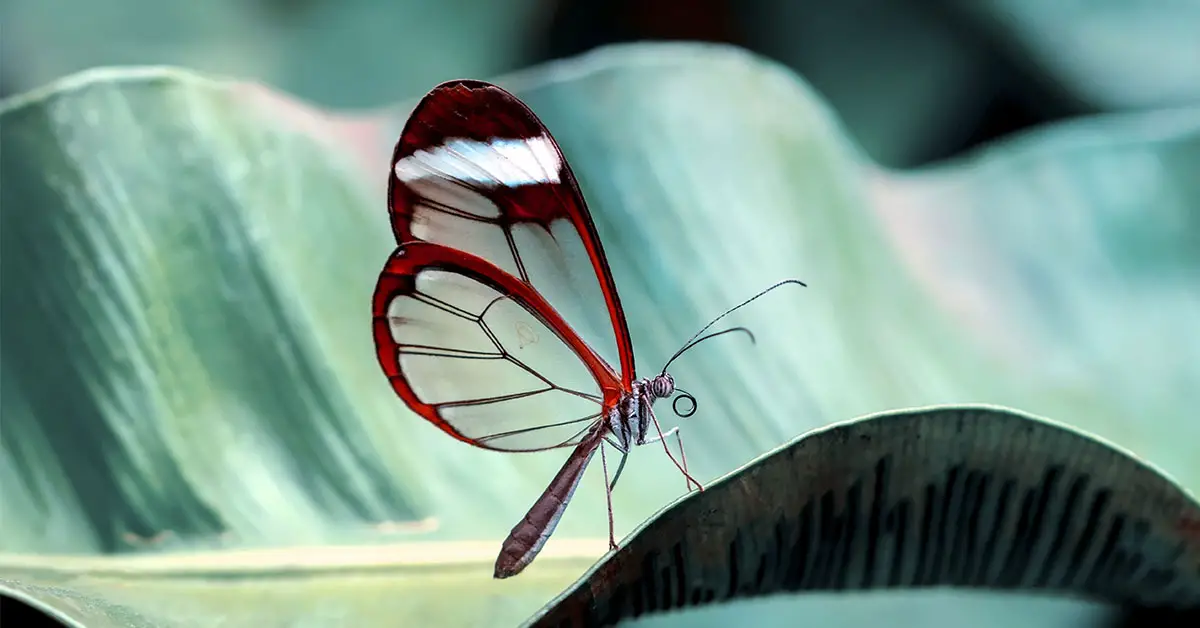The butterfly species are full of vibrant colors. There’s the monarch butterfly with bright orange wings or the blue morpho butterfly found in tropical rainforests. But the glasswing butterfly doesn’t stand out because of its colors; it stands out because of the lack of them. Its wings are almost completely transparent to help them hide from predators in plain sight.
The Science Behind the Glasswing Butterfly
A team of researchers set out to learn the nature behind the see-through wings. While transparency is found in nature, it’s more common among marine creatures, not butterflies. “It’s an interesting biological question because there just aren’t that many transparent organisms on land,” said study lead author Aaron Pomerantz, a biologist at the University of California, Berkeley. “So we asked the question, what is the actual developmental basis of how they create their transparent wings?”
The team analyzed these well-named wings under a microscope to better understand the biology at work. In each transparent wing membrane, there are anti-reflective scales. Of all of the unique forms of camouflage found in nature, half-invisibility takes the crown. But animals with this transparent quality have to ensure their bodies reflect or scatter light as little as possible.
Pomerantz became intrigued with the glasswing butterfly while researching in Peru, where he saw them in action. “They were really interesting and mysterious,” he says, “like these little, invisible jets that glide around in the rainforest.” [1]
The research team for this study includes co-author MBL Director Nipam Patel. The study was inspired by a class Patel taught at the MBL’s Embryology course. He brought his collection of transparent butterflies and moths for the students to examine. “A group of students took that on by imaging the wings with various microscopes,” Patel explained. “And they realized that pretty much any way you could think to make the wing transparent, some butterfly or moth had figured out how to do it. That’s what got us looking in more detail at the development of transparency.”
How do the Wings Look Transparent?
With the microscopes, Pomerantz and his colleagues examined the black rims of the wings. They were packed with flat scales that resembled scales. However, the transparent part of the wing had scales shaped like bristles set far apart from each other. These scales are important even though they prevent total transparency. The water-repellent properties of the scales prevent the wings from sticking together when caught in the train.
The waxy texture of the wings’ membrane also reduces the amount of light able to reflect off the transparent sections. If the membrane surface was flat, it would bring more light reflection, ruining the transparent effect. The researchers discovered that these sections of the wings naturally reflect on 2% of light. But when they took the waxy layer off the membrane, the wings reflected 2.5 times more light than usual.
Even among the other opaque creatures, the glasswing butterfly’s wings stand apart because of their few scales and their unique bristle-like shapes, which allows sunlight to stream through the wings instead of reflecting off of it. “As humans, we think we’re so brilliant because we figured out how to put anti-glare coating on glass, but butterflies basically figured that out tens of millions of years ago,” Patel said. Their research could inspire advances in anti-reflective coatings for devices like camera lenses and solar panels. [2]
Facts about the Greta oto
As a species, glasswing butterflies, or Greta oto, are commonly found in rainforests in Central and South America. They live only about six to 12 weeks. Their diet is primarily nectar from various flower species but they also eat flowers and bird droppings. They might look delicate but they can carry up to 40 times their body weight. [3] In fact, the male butterflies eat nectar and tissue of poisonous plants then pass the toxin to the females during mating. These poisons make these creatures and their eggs unpalatable. An unsuspecting predator will need only one unpleasant bite to learn never to mess with these butterflies again. As a result, many glasswing butterfly species evolved to resemble each other, giving them safety in numbers as predators learn to avoid them.
While the species living in the Amazon rainforest are largely undisturbed, the glasswing butterflies in the tropical Andes Mountains risk losing their habitat because of land conversion for agriculture. In a 2021 study, researchers observe and map the species habitats with plans for proper conservation for threatened areas. “With more accurate maps of butterfly distributions, we can identify species and communities that currently lack protection, to more effectively focus limited resources where they are most needed,” said Keith Willmott, curator and director of the Florida Museum of Natural History’s McGuire Center for Lepidoptera and Biodiversity. [4]
Sources
- “New images clarify how glasswing butterflies make their wings transparent.” Science News. Maria Temming. June 21, 2021
- “The glasswing butterfly has a unique type of transparency.” Earth.com. Chrissy Sexton. November 6, 2021
- “Glasswing (Greta oto).” Butterfly Identification.
- “Map of transparent butterflies highlights biodiversity hotspot in the Andes Mountains.” Science Daily. Florida Museum of Natural History. December 16, 2021

